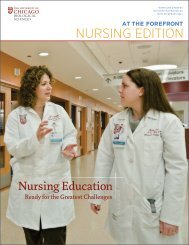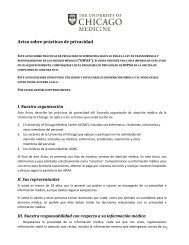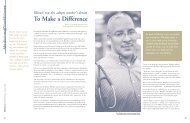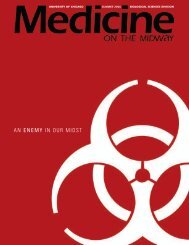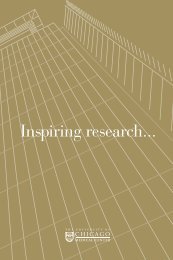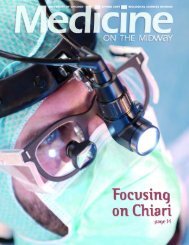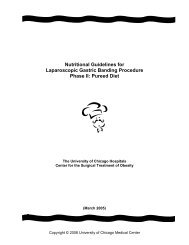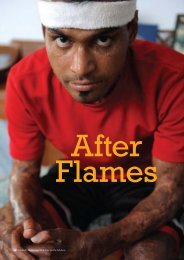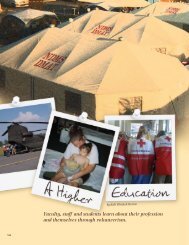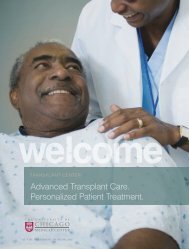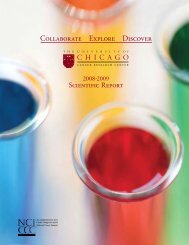AT THE FOREFRONT OF OUR COMMUNITY
2011 Community Benefit Report: The University of Chicago Medical ...
2011 Community Benefit Report: The University of Chicago Medical ...
- No tags were found...
You also want an ePaper? Increase the reach of your titles
YUMPU automatically turns print PDFs into web optimized ePapers that Google loves.
Improving Urban Health: Community ClinicsIn September 2010, Gwendolyn Gilmorewas one of the first patients to visitthe new CommunityHealth Englewoodclinic, just blocks from her home.“The staff here really listens to you,”said Gilmore, a 60-year-old senior careworker. “There are a lot of uninsuredpeople around here, and I tell them tocome on over.”In its first three months of operation, about 250 patientsvisited the Englewood clinic, which is open two half-days perweek and staffed predominantly by University of Chicagoresidents. In its first nine months, 1,020 uninsured patientsvisited the clinic. About a third of them were new patients.Twenty-eight of those patients were referred from theUniversity of Chicago Medical Center.During the same time, the Medical Center and theUniversity of Chicago’s Department of Medicine gave 1,302hours of resident time and 316 hours of faculty time to theEnglewood clinic, dedicated exclusively to the delivery ofdirect patient care. The services provided by the facility includehelping patients manage hypertension and diabetes — twocommon chronic conditions in the community.“We’re improving health literacy,” said Amber Pincavage, MD,then chief resident of internal medicine, now on faculty as oneof the internal medicine clerkship directors. She supervisesresidents at the clinic, a satellite site of CommunityHealth WestTown, the largest volunteer-based free clinic in Illinois. “Primarycare is a new concept for many uninsured patients who havealways relied on walk-in clinics and emergency rooms.”CommunityHealth West Town and Englewood are two offour free clinics staffed at least in part by students and medicalresidents from the University of Chicago. The other two —Washington Park Children’s Free Health Clinic and the MariaShelter — are led by Pritzker School of Medicine studentsunder the supervision of faculty volunteers.Pritzker medical students serve multiple roles in the fourclinics, such as counting medications or showing patients withdiabetes how to give themselves insulin injections, as well asconducting medical histories and physical exams overseen byfaculty volunteers. Medical residents serve as primary carephysicians to uninsured patients one half day per week.“These clinics offer uninsured or underinsured patients accessto health care they would otherwise not have,” said James1,020uninsured patients seenby University of Chicago residentsat the Englewood clinicin its first nine months4,000hours volunteeredby medical residentsat the Englewood clinic$50,000contributed by UHIto help sustain and expandthe Englewood clinicWoodruff, MD, associate dean of students for Pritzker, whooversees residents at the Englewood clinic. “You can think ofthese clinics as the safety net of the safety net.”Andrew Davis, MD, associate professor of medicine at theUniversity of Chicago and faculty adviser for the MariaShelter, views the volunteer work in clinics as a basicresponsibility for physicians in a nation where approximately50 million people don’t have access to health care.“It sensitizes students and residents to the calling of medicineand the social responsibility to promote health for all and notjust for those who can afford to pay,” Davis said.8University of Chicago Medicine



